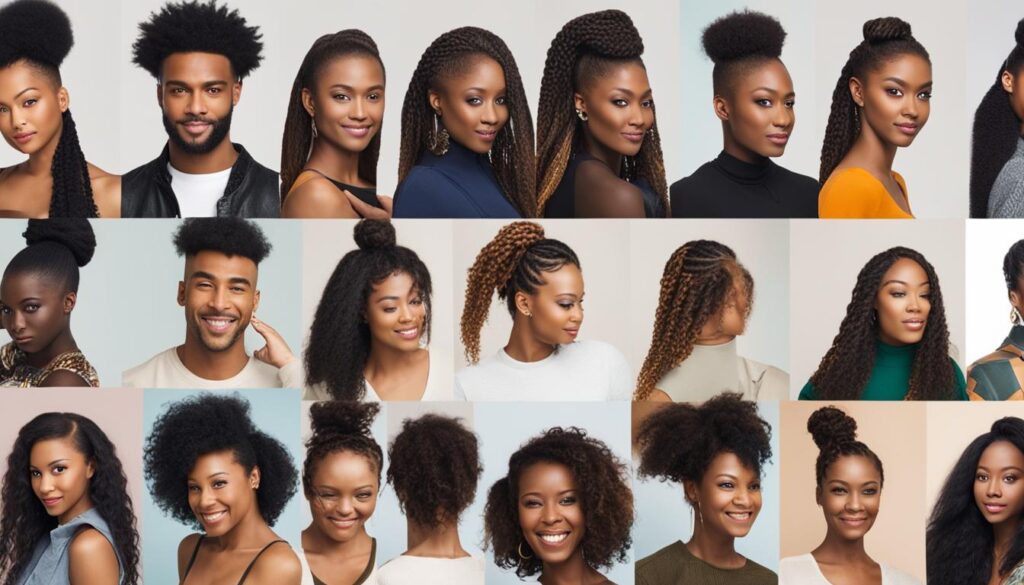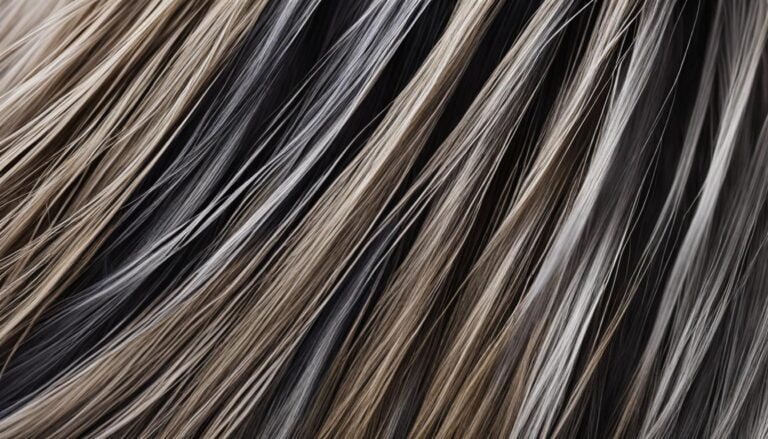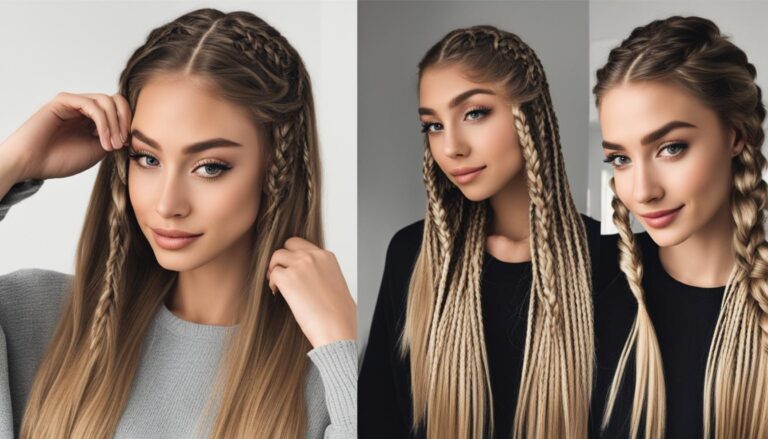Do Braids Damage Your Hairline?
Braids have been a popular hairstyle for centuries, known for their beauty and versatility. However, there is a concern among many individuals about the potential damage braids can cause to the hairline. It is important to understand the impact of braids on your hairline and take preventive measures to maintain its health.
When braids are worn too tightly or for extended periods of time, they can exert excessive tension on the hair follicles, leading to a condition called Traction Alopecia. This type of hair loss can result in a receding hairline, thinning hair, and even baldness. Itching, inflammation, and hair breakage are also common symptoms of Traction Alopecia.
To prevent hairline damage caused by braids, it is essential to be gentle when washing your braids and avoiding tight pulling of the hair. Switching up hairstyles and giving your hair a break from braids can also help alleviate the pressure on your hairline. Additionally, maintaining a balanced diet and using hair loss or thinning treatments can promote hairline health and prevent further damage.
Key Takeaways:
- Braids can potentially cause damage to the hairline if not cared for properly.
- Traction Alopecia is a type of hair loss that occurs due to repeated pulling of the hair from tight hairstyles like braids.
- Symptoms of Traction Alopecia include bumps, blisters, itching, and hair breakage.
- To prevent hairline damage, be gentle when washing braids and avoid tight pulling of the hair.
- Switching up hairstyles and using hair loss or thinning treatments can help promote hairline health.
What Is Traction Alopecia?
Traction Alopecia is a form of hair loss caused by repeated pulling on the hair. It was first discovered in the early 1900s when women wearing tight ponytails experienced hair loss along their hairline. Men who frequently wear tight hairstyles like braids, cornrows, twists, and dreadlocks are also at risk of developing Traction Alopecia.
Symptoms of Traction Alopecia include bumps, blisters, itching, hair breakage, and inflammation of the hair follicles. The hair loss is usually localized to the areas where the hair is pulled, such as the front and sides of the head. It’s important to note that Traction Alopecia has distinct symptoms different from other types of Alopecia.
Proper care and preventive measures can help avoid hairline thinning caused by Traction Alopecia. Being gentle when washing braids, less frequent re-twisting, switching up hairstyles, and incorporating hair loss or thinning treatments can be beneficial in preventing hairline damage from tight hairstyles like braids.
Symptoms of Traction Alopecia:
- Bumps and blisters on the scalp
- Itching and inflammation of the hair follicles
- Hair breakage and thinning in areas where hair is pulled
Traction Alopecia has distinct symptoms different from other types of Alopecia.
Preventive Measures for Traction Alopecia:
- Be gentle when washing braids to avoid excessive tension on the hair
- Limit re-twisting to reduce strain on the scalp
- Switch up hairstyles to relieve pressure on specific areas of the hairline
- Incorporate hair loss or thinning treatments recommended by a professional
How Can Traction Alopecia Be Prevented?
Preventing Traction Alopecia involves taking proper care of your hair and scalp. Here are some essential preventive measures to consider:
- Gentle washing of braids: Be mindful of the tension applied to your hair while washing. Use a gentle touch and avoid rubbing the scalp vigorously.
- Safe dreadlocking: If you have dreadlocks, ensure they are installed by a professional and avoid excessive tightness during the process.
- Switching up hairstyles: Give your hairline a break by alternating between braided and unbraided styles. This can help relieve pressure on the scalp and reduce the risk of hairline damage.
- Avoiding chemical treatments: Minimize the use of harsh chemical treatments that can weaken your hair and make it more prone to breakage. Opt for natural, gentle alternatives instead.
- Hair loss or thinning treatment: Consider using hair loss or thinning treatments specifically designed to prevent future hair loss and encourage hair regrowth.
- Keeping braids at an optimal length: Avoid excessively long or heavy braids that can put strain on the hair follicles. Opt for a length that feels comfortable and manageable.
- Using essential oils for haircare: Incorporate essential oils into your haircare routine to nourish and strengthen your hair. Some beneficial oils include lavender, rosemary, and peppermint.
- Avoiding tight pulling of dreadlocks: Be gentle when styling and maintaining your dreadlocks to avoid excessive tension on the hairline.
- Protecting dreads while sleeping: Wear a satin or silk bonnet or use a satin pillowcase to minimize friction and protect your hair while you sleep.
- Seeking professional loctician services: If you have dreadlocks, consult a professional loctician for regular maintenance and guidance on keeping your hair and scalp healthy.
- Scalp massaging for better blood circulation: Regularly massage your scalp to improve blood flow and promote overall hair health. You can use your fingertips or a scalp massager for this purpose.
By incorporating these preventive measures into your haircare routine, you can significantly reduce the risk of hairline damage caused by braids and other tight hairstyles.

Effects of Tight Hairstyles on Receding Hairlines
Wearing tight hairstyles, such as braids, can have detrimental effects on the hairline and overall scalp health. The constant tension created by these styles puts excessive strain on the hair follicles, leading to breakage, hair loss, and even receding hairlines. Initially, hair thinning may go unnoticed, especially in individuals with curly hair, as the curls can hide thin areas on the scalp. However, continued wear of tight hairstyles can worsen hair thinning and further compromise the health of the hair.
Scalp soreness is another common issue experienced by individuals who wear tight braids. The tightness of the braids can cause discomfort, itchiness, and inflammation. In more severe cases, the scalp may develop scabs and blisters, which can ultimately result in additional hair loss.
Proper maintenance and handling of tight hairstyles are crucial in minimizing the risk of these negative effects. It is important to avoid pulling the hair too tightly and to give the scalp regular breaks from tight hairstyles. Additionally, using gentle hair care practices, such as washing the hair with care and avoiding excessive manipulation, can help preserve the health of the hairline. If scalp soreness or other symptoms persist, seeking professional advice from a dermatologist or trichologist is recommended.
Preventive Measures for Healthy Hairlines
- Avoid wearing tight hairstyles for extended periods of time
- Give the scalp regular breaks from tight hairstyles
- Be gentle when handling and styling the hair
- Practice proper hair care routines, including regular washing and conditioning
- Use products specifically designed to promote hair health and prevent hair loss
- Avoid excessive heat styling and chemical treatments
- Maintain a balanced diet and stay hydrated for optimal hair growth
It is important to prioritize the health of your hair and scalp when choosing and maintaining hairstyles. By taking preventive measures and being mindful of the potential risks of tight hairstyles, you can help minimize the chances of hairline damage and maintain a healthy, full head of hair.
The Link Between Braids and Irreversible Hair Loss
Wearing braids can be a stylish and convenient hairstyle choice, but it is important to be aware of the potential risks associated with prolonged wear. One such risk is Central Centrifugal Cicatricial Alopecia (CCCA), a type of permanent hair loss that commonly affects individuals who wear tight braids, especially African-American females. CCCA starts at the central parting of the scalp and gradually spreads towards the edges, resulting in irreversible baldness. This condition is believed to be caused by the chronic tension and pulling on the hair follicles that occurs with tight braids.
Traction alopecia is another concern when it comes to braids and hair loss. This form of hair loss is caused by repeated pulling and tension on the hair, often due to tight hairstyles such as braids. Traction alopecia is particularly prevalent in African-American females due to the frequent use of braided hairstyles. The constant strain on the hairline can lead to hair breakage, thinning, and eventually irreversible damage to the hair follicles.
While braids can be a beautiful and versatile hairstyle, it is crucial to take precautions to minimize the risk of irreversible hair loss. Avoid wearing braids for extended periods and give your hair and scalp regular breaks between styles. Be mindful of the tension and tightness of your braids, ensuring they are not pulling excessively on your hairline. It is also important to maintain a healthy scalp by keeping it clean, moisturized, and free from irritation or inflammation. Consulting with a professional stylist who specializes in braids can provide valuable guidance on safe and low-tension braiding techniques.
Remember, the key to preserving the health of your hairline while enjoying braided hairstyles is to strike a balance between style and scalp health. By being mindful of the risks and taking appropriate measures to care for your hair and scalp, you can minimize the chances of irreversible hair loss and maintain the beauty and longevity of your braided hairstyles.
Conclusion
Wearing braids can potentially damage the hairline if not cared for properly. Traction Alopecia, a form of hair loss caused by repeated pulling on the hair, is a common risk associated with tight hairstyles like braids. Symptoms of Traction Alopecia include bumps, blisters, itching, and hair breakage.
Preventive measures such as being gentle when washing braids, avoiding tight pulling of dreadlocks, switching up hairstyles, avoiding chemical treatments, and using hair loss or thinning treatments can help minimize the risk of hairline damage caused by braids. Proper maintenance and professional guidance for braids and other tight hairstyles are essential to maintain hair and scalp health.
Prioritizing the health of your hair can help preserve the longevity of your braids or dreads.
FAQ
Do braids damage your hairline?
Yes, braids can potentially cause damage to the hairline if not cared for properly. Tight hairstyles like braids can lead to Traction Alopecia, a type of hair loss that occurs when hair is repeatedly pulled.
What is Traction Alopecia?
Traction Alopecia is a form of hair loss caused by repeated pulling on the hair. It is commonly seen in individuals who wear tight hairstyles like braids, cornrows, twists, and dreadlocks. Symptoms include bumps, blisters, itching, hair breakage, and inflammation of the hair follicles.
How can Traction Alopecia be prevented?
Preventing Traction Alopecia involves being gentle when washing braids, using safe dreadlocking techniques, less frequent re-twisting, switching up hairstyles, avoiding frequent chemical treatments, and using hair loss or thinning treatments. Keeping braids at an optimal length, incorporating essential oils into the haircare routine, avoiding tight pulling of dreadlocks, protecting dreads while sleeping, seeking professional loctician services, and scalp massaging can also help prevent hairline damage caused by braids.
What are the effects of tight hairstyles on receding hairlines?
Tight hairstyles, including braids, can cause strain on the hair follicles, leading to breakage, hair loss, and receding hairlines. They can also cause scalp soreness, itchiness, inflammation, and the development of scabs and blisters.
What is the link between braids and irreversible hair loss?
Prolonged wearing of braids can increase the risk of a type of permanent hair loss called Central Centrifugal Cicatricial Alopecia (CCCA). Traction alopecia, a form of hair loss caused by chronic pulling and tension on the hair follicles, is commonly seen in African-American females who wear tight braids or cornrows.







